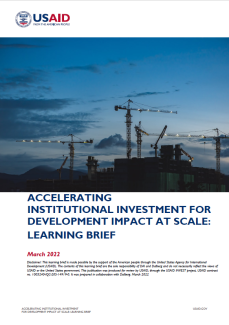Accelerating institutional investment is essential to achieving the Sustainable Development Goals (SDGs). The widening SDG financing gap has only been exacerbated by COVID and is currently estimated at USD 4.2 trillion. With official development assistance estimated at USD 161 billion, an all-time high, the development community must rely on alternative sources of funding. Globally, USD 379 trillion is held in financial assets. 1 With 80 percent of this held in developed economies, there is massive opportunity to reallocate even just a small portion of these assets to fill the SDG financing gap. 2 With emerging market GDP growth outpacing that of developed economies, 6.5 percent compared to 5.0 percent respectively, and this trend set to continue into the foreseeable future, emerging markets could be an attractive destination for institutional investors who typically seek longer-term investments if barriers to investment can be overcome.3 The longer-term, larger investments of institutional investors are particularly well-suited to drive development impact in sectors such as sustainable infrastructure which require patient capital. Moreover, institutional investors in their own right are becoming increasingly interested in ensuring that their investments drive social impact, as illustrated by initiatives such as the Principles for Responsible Investment and Net Zero Asset Managers initiative which aim to integrate environmental, social, and governance (ESG) factors into investment decision making.
Breadcrumb
- Home
- INVEST
- INVEST Publications
- Institutional Investment For Development Impact At Scale: Learning Brief

